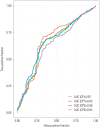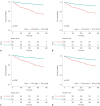Does a Gradient-Adjusted Cardiac Power Index Improve Prediction of Post-Transcatheter Aortic Valve Replacement Survival Over Cardiac Power Index?
- PMID: 32469172
- PMCID: PMC7256004
- DOI: 10.3349/ymj.2020.61.6.482
Does a Gradient-Adjusted Cardiac Power Index Improve Prediction of Post-Transcatheter Aortic Valve Replacement Survival Over Cardiac Power Index?
Abstract
Purpose: Cardiac power (CP) index is a product of mean arterial pressure (MAP) and cardiac output (CO). In aortic stenosis, however, MAP is not reflective of true left ventricular (LV) afterload. We evaluated the utility of a gradient-adjusted CP (GCP) index in predicting survival after transcatheter aortic valve replacement (TAVR), compared to CP alone.
Materials and methods: We included 975 patients who underwent TAVR with 1 year of follow-up. CP was calculated as (CO×MAP)/[451×body surface area (BSA)] (W/m²). GCP was calculated using augmented MAP by adding aortic valve mean gradient (AVMG) to systolic blood pressure (CP1), adding aortic valve maximal instantaneous gradient to systolic blood pressure (CP2), and adding AVMG to MAP (CP3). A multivariate Cox regression analysis was performed adjusting for baseline covariates. Receiver operator curves (ROC) for CP and GCP were calculated to predict survival after TAVR.
Results: The mortality rate at 1 year was 16%. The mean age and AVMG of the survivors were 81±9 years and 43±4 mm Hg versus 80±9 years and 42±13 mm Hg in the deceased group. The proportions of female patients were similar in both groups (p=0.7). Both CP and GCP were independently associated with survival at 1 year. The area under ROCs for CP, CP1, CP2, and CP3 were 0.67 [95% confidence interval (CI), 0.62-0.72], 0.65 (95% CI, 0.60-0.70), 0.66 (95% CI, 0.61-0.71), and 0.63 (95% CI 0.58-0.68), respectively.
Conclusion: GCP did not improve the accuracy of predicting survival post TAVR at 1 year, compared to CP alone.
Keywords: Aortic valve stenosis; hemodynamics; mortality; transcatheter aortic valve replacement.
© Copyright: Yonsei University College of Medicine 2020.
Conflict of interest statement
The authors have no potential conflicts of interest to disclose.
Figures




Similar articles
-
Utility of Cardiac Power Hemodynamic Measurements in the Evaluation and Risk Stratification of Cardiovascular Conditions.Healthcare (Basel). 2022 Nov 30;10(12):2417. doi: 10.3390/healthcare10122417. Healthcare (Basel). 2022. PMID: 36553940 Free PMC article. Review.
-
Hemodynamic Assessment of Aortic Regurgitation After Transcatheter Aortic Valve Replacement: The Diastolic Pressure-Time Index.JACC Cardiovasc Interv. 2016 May 23;9(10):1061-8. doi: 10.1016/j.jcin.2016.02.012. Epub 2016 Apr 27. JACC Cardiovasc Interv. 2016. PMID: 27131441
-
Blood Pressure and Arterial Load After Transcatheter Aortic Valve Replacement for Aortic Stenosis.Circ Cardiovasc Imaging. 2017 Jul;10(7):e006308. doi: 10.1161/CIRCIMAGING.116.006308. Circ Cardiovasc Imaging. 2017. PMID: 28701528
-
Dynamic changes in aortic impedance after transcatheter aortic valve replacement and its impact on exploratory outcome.Int J Cardiovasc Imaging. 2017 Nov;33(11):1693-1701. doi: 10.1007/s10554-017-1155-6. Epub 2017 May 17. Int J Cardiovasc Imaging. 2017. PMID: 28516313
-
Transapical Transcatheter Aortic Valve Replacement Is Associated With Increased Cardiac Mortality in Patients With Left Ventricular Dysfunction: Insights From the PARTNER I Trial.JACC Cardiovasc Interv. 2017 Dec 11;10(23):2414-2422. doi: 10.1016/j.jcin.2017.09.023. JACC Cardiovasc Interv. 2017. PMID: 29217004 Clinical Trial.
Cited by
-
Utility of Cardiac Power Hemodynamic Measurements in the Evaluation and Risk Stratification of Cardiovascular Conditions.Healthcare (Basel). 2022 Nov 30;10(12):2417. doi: 10.3390/healthcare10122417. Healthcare (Basel). 2022. PMID: 36553940 Free PMC article. Review.
-
Transcatheter Aortic Valve Replacement Prognostication with Augmented Mean Arterial Pressure.J Cardiovasc Dev Dis. 2023 Apr 26;10(5):192. doi: 10.3390/jcdd10050192. J Cardiovasc Dev Dis. 2023. PMID: 37233159 Free PMC article.
-
Futility in TAVI: A scoping review of definitions, predictive criteria, and medical predictive models.PLoS One. 2025 Jan 9;20(1):e0313399. doi: 10.1371/journal.pone.0313399. eCollection 2025. PLoS One. 2025. PMID: 39787130 Free PMC article.
References
-
- Cotter G, Moshkovitz Y, Kaluski E, Milo O, Nobikov Y, Schneeweiss A, et al. The role of cardiac power and systemic vascular resistance in the pathophysiology and diagnosis of patients with acute congestive heart failure. Eur J Heart Fail. 2003;5:443–451. - PubMed
-
- Cotter G, Moshkovitz Y, Milovanov O, Salah A, Blatt A, Krakover R, et al. Acute heart failure: a novel approach to its pathogenesis and treatment. Eur J Heart Fail. 2002;4:227–234. - PubMed
-
- Marmor A, Schneeweiss A. Prognostic value of noninvasively obtained left ventricular contractile reserve in patients with severe heart failure. J Am Coll Cardiol. 1997;29:422–428. - PubMed
-
- Williams SG, Cooke GA, Wright DJ, Parsons WJ, Riley RL, Marshall P, et al. Peak exercise cardiac power output; a direct indicator of cardiac function strongly predictive of prognosis in chronic heart failure. Eur Heart J. 2001;22:1496–1503. - PubMed
-
- Cohen-Solal A, Tabet JY, Logeart D, Bourgoin P, Tokmakova M, Dahan M. A non-invasively determined surrogate of cardiac power (‘circulatory power’) at peak exercise is a powerful prognostic factor in chronic heart failure. Eur Heart J. 2002;23:806–814. - PubMed
Publication types
MeSH terms
LinkOut - more resources
Full Text Sources
Miscellaneous

